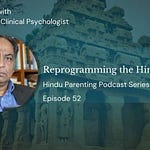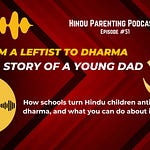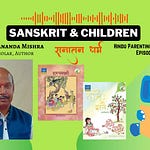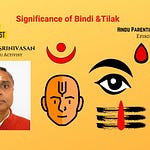In this episode, we talk about the festival of Mahashivarathri.
We converse with Sheela, a Shiva bhakta and a working mother. In a lighthearted and meaningful discussion on the festival from within the Lingayat tradition, we also touch upon many concepts of Hinduism and have a delightful chat about typical Hindu parent experiences!
What is the story behind the origin of Shivaratri? Why do we fast? Why do we do abhishekam to the shivalinga? Learn Hindu terminology and make sure kids know it - What is haalaahala, upavasa, jyotirlinga, Shiva Panchakshari Stotra? Who among the devathas is Abhisheka priya? Who is Alankara priya?
Listen for interesting bits of information, stories and parenting tips. Please share with all Hindu parents!
Note: If you find our work valuable, please consider making a contribution. It will help us cover the costs of reaching many more Hindu parents.
If you live outside India, please use the substack platform (through Stripe). If you live in India, please write to contact@hinduparenting.org to get the QR code.
General Information
For comments and suggestions, please use the comments tab or write to us at contact@hinduparenting.org
Please note that questions will not be answered on email.
Do subscribe to our substack and follow us on our social media handles
Twitter: hinduparenting
Instagram: hinduparenting
Telegram: t.me/hinduparenting
Facebook: facebook.com/hinduparenting
Facebook: facebook.com/groups/hinduparenting
Threads: hinduparenting
Koo: hinduparenting
The opinions expressed by guests on The Hindu Parenting Podcast are their personal opinions and Hindu Parenting does not assume any responsibility or liability for the accuracy, completeness, suitability or validity of anything shared on our platform by them.
Copyright belongs to Hindu Parenting.
Transcript
Rekha
Namaste!
Welcome to the Hindu Parenting podcast. As we pointed out in the previous episode, ours is a celebratory culture. Almost every day in our calendar is filled with a celebration of nature or episodes from our rich itihasas and puranas. Our ways of celebration are equally rich and diverse. Today, we will be talking about the festival of Maha Shivaratri. So, when does Shivaratri occur according to the Indian calendar, traditionally known as the Panchangam? The 14th day or chaturdashi of Krishna paksha just before the new moon marks Shivaratri every month, making it 12 Shivaratris in all, but the Shivaratri that falls on Krishna paksha chaturdashi in the month of Magha, or Phalgun, depending on the specific panchang is called the Maha Shivratri. To discuss this festival, we have Sheela, a Shivabhakta, and a working mother. Shalini and I will be talking to her about the festival and how she celebrates it as a person from the Lingayat community. Namaskara and welcome, Sheela.
Sheela: Namaskara Rekha, Shalini. Thank you so much for having me on your podcast.
Rekha: It's a pleasure to have you on our podcast. Shall we dive right in? First, can you help us understand the significance of the festival? And what are the stories behind Shivaratri?
Sheela: Sure. As we all know, the Shivaratri is celebrated every month or there is a Shivaratri every month, or day before the amavasya is considered Shivaratri every month. But in the Magha maasa, we celebrate Maha Shivratri. It is believed that when the samudra manthana happened, there was amrita and visha that came out of the samudra manthan, after the churning of the sea. So when the poison had generated, it caused a lot of problems even to the God. So Shiva offered to consume this haalahala is what they call it. So it so happened that when he consumed it…
Shalini: Sorry, what is called haalahala?
Sheela: The poison or visha, what we say. Vish, that is called haalahala. Okay, so amrita and haalahala, is what it's called. Shiva is the Lord of the world, is what we call Jagaddodharaka. So for the uddhara of pruthvi or this sampoorna loka, he came forward and said that he would consume that and dissolve that so it doesn't affect the whole world. So when he consumes this haalahala, when it's flowing down his throat, Parvati comes and holds his throat so it doesn't enter his body system. So that's how his throat has turned blue. So if you if you see the picture of Lord Shiva, it is always shown that his neck is blue in color, that’s the reason he's also got the name Neelakantha. We can relate this to a story like how in the villages, if a person is bitten by a poisonous snake, he is kept awake for 24 hours. So that is what happened when Shiva consumed the haalahala, all the devas and devatas and the devis kept him awake by singing and dancing and performing different activities. This kept Lord Shiva awake. So that is a reason that we perform pujas on Shivaratri. So in the same way they did not eat anything. It's it's also…you can think this way; like if the head of the family, okay is unwell, can we eat anything? We won't be in a mood to eat because he's unwell. So that was one of the reasons they did upavaasa. Upavaasa also has an explanation for the word. “Upa” was, it said that, “at the threshold of God”. Vaasa means “living”, right. So at the footsteps or at the threshold of God's presence is what is upavaasa, they say. So, that was one of the reasons why they do upavaasa. And why they do jaagarane. They stay awake with the Lord, to help him overcome this, this reaction of the poison, okay by keeping him awake, because once a person sleeps, it may damage the whole system. And that was one of the reason why they keep the person who consumes or who has been bit by sneak awake for 24 hours.
Shalini: I think you should come again on that upavaasa bit. Because vaasa, as you said, That's understood that you're talking about the abode of somebody, or where somebody stays, what does upa mean?
Sheela: Upa means near and vaasa means to stay.
Shalini: Okay, you're staying near the God who has consumed this haalahala. And you're keeping vigil for that person, with him. Right?
Sheela: Along with him. Yeah, any fasting is called upavaasa. So you're close to God, it means that you're close to God.
Rekha: Okay, so the purpose of fasting is to be close to God, not just to simply abstain from food. The whole purpose behind any kind of fasting upavaasa that we observed for many of our rituals and festivals is to not eat and thereby stay close to God think thinking of our devi or devata? Whichever occasion.
Shalini: Right. This is very interesting, what we use the term upavaasa is to denote fasting, but the word itself does not have that meaning at all. Actually, I think it's an interesting word. It just occurred to me when you said it.
Rekha: Yeah, I'm thinking it may have something to do with the proliferation of two meanings. You know, Sanskrit is a language that, that has different meanings for every word. So when you say, yeah, so in some way, I think what we are referring to by using the word upavaasa must be its underlying meaning, not the on the surface meaning of just staying away from food, but the underlying reason for it. So that has become coming into usage.
Sheela: I would like to add something to this is when you're doing something that you want to achieve, or something that you like to do, or enjoy doing it, you're focused on it. When you're focused on something; imagine a child that likes to play, okay, doesn't think of food or anything, who’s enjoying doing the whole act of playing, will not think of food or anything to drink. The game.
Shalini: Very interesting point that you know, because when all focus is on some activity, you really are not concerned about food, drink anything. You're concerned only about what you're doing. So I think that's a great point.
Rekha: Especially all of us definitely know how hard it is to drag a screaming child away from play to eat.
Shalini: That's, that's absolutely true. Yeah.
Sheela: So all of us become children when it is the creator that the supreme energy, so
Shalini: That's very, very nice way to put it. Yeah. So, Sheela, Shiva is worshipped in many forms, okay. I mean, you see a picture of Shiva on on his vaahana which is Nandi. Sometimes you just see a picture of Shiva with Parvati and their children, but the most common one is the form in which he is worshipped as a linga. So, why do you think that Shiva is represented as a linga?
Sheela: Okay. Like, we all know energy does not have a shape. So, Shiva himself has no shape is what they say.
Shalini: Yeah, I mean, Linga also actually means just a representation no in Sanskrit? Linga is the sign,
Rekha: Yeah, the representation of Shiva linga. Linga is the word in Sanskrit word for a sign. So Shiva is represented as a linga and a linga is column of light with no beginning and no end. And when you worship Shiva as a linga, it just means you worship him as this unending, infinite source of light and fire. It's supposed to be a column of fire with no beginning and end. And interestingly the Jyotirlingas are well known to all practitioners of Hinduism. So the Jyotirlingas are supposed to be manifestations of this column or pillar of light, it's also called as sthambh. So the manifestation of the stambh in 12 different locations across India is the story behind Jyotirlingas. And some of the Jyotirlingas, where Bhagwan is represented as a column of light is places like Kedarnath, Mahakal temple in Ujjain.
Shalini: There is Trimbakeshwar in Maharashtra, also Bhimashankar in Maharashtra too, I think, yeah, then I think Somnath is also one of the Jyotirlingas right?
Rekha: They say that these are all swayambhu forms of Bhagwan because the Jyotirlingas are swayambhus which means that they have manifested by themselves without installing. So that is the significance of the 12 Jyotirlingas.
Shalini: So Sheela, Rekha has been saying that, you know, a column of light, fire. Actually, Shiva is always represented in this fiery form. There's always a kind of very intense energy associated with him, you know, why is that?
Sheela: Yes, as I mentioned, in the beginning, Jagaddhodharaka. So, he is believed to take away all the negatives from the creatures of his own creation, right. So he has created this world is what we believe. So in this world, whatever negatives that are there and that's the reason we go to any temple, okay? To gain energy from them, we don't go there to ask for something, we just try to, it's like, we are recharging our energies, okay. So, every time when we talk, we always say, think positive be positive, okay. So, it is believed that Eeshwara or Jagadeeshwara or Jagadoddharaka draws all the negatives. So, when he is taking all of the negatives, like how he consumed the haalahala, he is considered to be you know, his system is they say that he's very hot. So, any shaivaite if you ask them… He is believed to be abhisheka priya is what they say. If you go to any Shiva temple, you will see that there are drops of water falling on the Shivalinga that is there in the sanctum. It is said that the Shivalinga always needs to be cooled down like, you said Agni or fire that he's holding in his system has to always… you have to cool it so, that's one of the reasons why these water drops keep falling on the Shivalinga. And even if you can connect that to your family as such, it is believed that eeshanya moole in vaastu is what they say, in a house where the north and east coincide is called the eeshanya corner Okay. So, in that corner, even now in certain houses, they follow this ritual of or custom of keeping a vessel of copper or any vessel that has water and so, it is believed that when you keep this water which has to be changed every day, and the vessel has to be clean, and you refill the water, this signifies that like every house has an owner, so to keep them calm or the whole setup of the house to be calm, it is believed that when you keep water there it keeps the whole house in a positive energy or positive environment.
Shalini: So that vessel is supposed to absorb all the negativities that arise in that space and imparts the positivity.
Sheela: Yes, because that corner is believed that is where Shiva is residing and that is one of the reasons they especially that corner if any house as that corner of it is good to make use of the space to keep at least a small vessel of water.
Shalini: So what are what are the abhishekams that Shiva basically likes?
Sheela
Shiva is as I mentioned is abhisheka priya and like how they say Vishnu is alankaara priya. So Shiva is abhisheka priya and you can just do abhisheka with water, nothing else. The least could be water otherwise, just panchamruta abhisheka is what they do normally. Or as we all know, he puts vibhuti, the ashes. So, since he's fond of vibhuti, so vibhuti is another thing but otherwise just by water. Me being a Lingayat, there were times when I used to not get flowers when I used to live in certain places. Even now when I do puja, since we have to do puja to our linga that we wear, every day it is said that we have to do thrice a day but with all the lifestyle that we have, I ensure that at least once in the morning, soon after my bath, I do the puja. I just apply vibhuti and the sandal paste and I just pour little bit of water and that is what is sufficient to keep him happy.
Shalini: It's very interesting. All the things that you mentioned, they're all coolants also. Water is a coolant, vibhuti is a coolant, sandalwood paste is a coolant, panchamruta is a coolant. So, I mean it's very consistent. Okay, if they say that he absorbs all the negative energies and so gets heated up and needs to be cooled. All the things that you're using to do abhisheka with for him are also coolants you know, so there is really no inconsistency in our practices. It's really beautiful to see this.
Rekha: Just as Sheela pointed out, abhisheka priya and alankaara priya! What are these two? You know, Bhagwan Shiva is known as abhisheka priya and Vishnu, any Avatar of Vishnu is supposed to like decoration, flowers, all the beautiful and aesthetic things. Whereas Shiva is more from an ascetic tradition. So Shalini, do you remember the discussion we were having when we discussed what it means to be a Hindu? And choosing one’s ishtadevata?
Shalini: Yes, absolutely.
Rekha: What Sheela has just said, ties into our devis and devatas having different personalities, you know, one liking the decoration aspect, one being more ascetically inclined, and how beautiful, how naturally diverse the tradition is and how we can choose an ishtadevata, depending on what resonates with our personality..just wanted to point that out.
Shalini: Exactly, exactly. That's what I'm saying. It's very consistent, you know, the theories, the practice, everything is consistent. It's for us to discover and appreciate it. It's really, every conversation that we have makes me more and more appreciative of the depth and profundity of our traditions. It's simply amazing. Okay, Sheela, while you were growing up, what was a typical festival day like? How did you celebrate the occasion of Maha Shivaratri?
Sheela: Alright. And as a child, what I can remember is, we wouldn't get to eat anything that's made with rice or we wouldn’t eat any cooked form of the rice. And my parents used to fast without having any grain. Okay, if we felt hungry, the food that we used to get would be fruits or anything that is made with wheat, and we would try our best to cooperate with our parents by not asking for any food because they are fasting themselves. So it wouldn't be right asking, demanding for something but then it was always a treat to have chapati because that was that is I'm sure even now, like my children, they like to eat chapati. It's not rice. And the whole day from morning till evening, they wouldn't eat anything. And again, they would have bath in the evening and all of us would have bath. And then they would do the abhisheka at home by chanting Rudra or simple Om Namah Shivaya is what we could chant. And then once the puja is done in the evening, around 6:30 or seven o'clock, I'm sure they used to even check for the right time when they will do the puja. And then once that is done, followed by phalahaara is what it's called. Any upavaasa they say phalahaara, it's phala, ahaara; you can have fruits if you want to break your fast or you can have a snack which is made of wheat. Normally in our house, my mom used to always make something with wheat, that would be upma. That was the common thing that would be made. And then we used to get to eat dry fruits and all with which we could eat any fruit if we feel hungry after we break the past. But there are some people who will not have anything at all. They may just have juice sometime, tender coconut is considered to be cooling. So they consumed a coconut and there are certain temples, like there's a temple near our house where I live. There on Shivaratri they have the tender coconut abhisheka. Elaneeru abhisheka is what they call it. So, they will be there they perform this on Shivaratri. And on that day, any temple that you go, a Shiva temple, they will serve you with prasada which will either be dates or it will be some snack which is made of wheat, like upma, is what they give in that temple also. So, there are a lot of devotees who contribute, they volunteer to sponsor the prasada on that day. So it is from morning till the next day morning that they keep, like, you know, puja keeps happening. But this elaneeru abhisheka happens till the evening, then there is another puja again, then there is a different alankaara of vibhuti that they do. And then it is followed by the bhajan and all that that they do.
Shalini: Yeah, so you you stay up all night? Or that was the practice, maybe it's not so anymore, but people would stay up all night, right? Yes. And what what would you do? I think you mentioned why we stay up. Because we are also keeping vigil along with the Lord so that, you know, he doesn't fall asleep and swallow that poison, which could affect him. So I think that's why we stay awake. But what would you do staying awake?
Sheela: So once you break the fast at home, when we used to break our fast, the next custom was to take us to the temple. So in those days, we had to walk a lot to go to a particular temple that my parents used to visit. So they used to be two, three Shiva temples that they used to take us to. So we used to walk after this, go visit… the farthest temple would be the first place that we would visit. So on our way back, we would go to another temple and then a temple that is much closer to where we used to stay then. Once we visit the temple, the next thing that would happen is to keep us awake for some time, they used to play a movie. So it was a standard movie. I remember two, three years, it would be the same movie. It used to be Shiva Purana story where, like Parvati is dreaming of being married to Lord Shiva, like all of us know the story, right? So the parvata raja story. And this was a movie that used to be played there. And that would go on for probably till midnight, till one o'clock, we used to stay in the temple. And then we used to walk back home. And you will see people all around that community moving around, so it wouldn't be like it is night. So we would come back and we would sleep. I really don't remember if my parents used to stay awake, but when we get up, they're awake again. So in the morning, that's how it used to be.
Rekha: This also shows the importance of community right? But for having a community it would be much harder to motivate children to stay awake or to take part in these festivities. But having a connectivity makes it so easy.
Shalini: Yeah, and you're right because there are plenty of families also who are taking advantage of big community celebrations in places like Sadguru’s Isha plus, I think there is Sri Sri Ravi Shankar’s Art of Living, they also have a whole night program for Shivaratri. So, I think there are opportunities to do things as a community. And then of course, there are the temples also, which always I think do full night programs on Shivaratri, yeah,
Rekha: Yeah, there are so many temples that have all night programs. So, you know, even the littlest ones can be taken to these programs, there are cultural events. And I have noticed the very little ones who come to see, like a music performance or a dance performance done by the older children and they get fascinated and they they beg to they ask their parents, can I also start learning so you know, these kinds of things are facilitated when you start having them participate. In India it is actually quite easy to find a local Shiva temple that has all night programs.
Sheela: In villages, normally they follow this jaagarane ritual very devotedly. There are plenty of temples which will have singing, there'll be some people who will be telling stories and be narrating stories. So they ensure that they are awake and there will be small children, they are the ones who will be the most energetic because it is believed on this day. They say that you can gain a lot of energy, especially for saadhaks who are looking forward to achieve something or to do some saadhana. They say that this is an ideal day to do your upavaasa and your jaagarane. So small children definitely enjoy the celebration, especially the jaagarane because it's, it's something unusual, they let them stay awake the whole night.
Rekha: Speaking of all night activities, and jaagarane, we can see how the performing arts play a major role in the life of a practicing Hindu. Shiva in his form of Nataraja, the king of natya is just so relatable for kids, don't you think? It is just such an active beautiful, aesthetic image and that's one easy way for kids to connect this whole thing of performing arts and Shivaratri. And then performing in a festival, staying awake at night and performing in a festival..
Shalini: dancing the night away with some rules and we cannot have any sort of dancing. But
Rekha: That’s true. Terminology is so important. Coming back to terminology which we touched in the very first or second podcast. So, dance is not simply dance for us. It is natya. Music is not simply music. It is sangeeta. Practitioners of classical dance, the gurus who make it a point to mention this. I remember meeting one of the renowned gurus and he had specifically said what is dance? Don't use the term dance. It is natya.
Shalini: yeah, I think that's that's something that we have to consciously do every day, you know, shed a little bit of the English, start using our own words, then the associated meanings also will come to us. And I think we'll all be better for that.
Rekha: Maybe we can also stop saying gods and goddesses and say devatas and devis, and..
Shalini: yeah, devatas and devis
Sheela: I would like to add something to this devi and devatas, devatas and devis. When you're referring to a couple they will always say Srimati and Shri, they will never say Shri and Srimathi. Unlike in English, they'll say Mr. and Mrs, no?
Shalini: Wow! That is something that's a very, very interesting point that you brought up.
Sheela: Even if you see, when you see an invitation, a wedding invitation, it will always be Srimati and Shri. So, the importance of a woman or the respect that is given for a woman is shown from not now, but from the ancient days. So they always give a lot of respect for a woman in Indian culture. Everywhere.
Shalini: Little things no, that we have not actually paid attention to but it makes a world of difference. You always write Srimathi and Shri. You will never write Shri and Srimathi. It even sounds wrong, you know.
Rekha: That’s because we've grown up hearing it said - Shrimathi and Shri, Devi and Devatha, it just flows so well. You notice that Shri itself means Lakshmi, right?
Shalini: Correct. Correct. I was going to raise that too! Good, you raised that Rekha.
Rekha: Can this word ‘Mr.’ ever mean “Goddess"? Think of how preposterous that sounds!
Shalini: ‘Mr.’ can never have a feminine element in it, no?
Rekha: Just like how Eve was fashioned out of a rib of Adam!
Shalini: Correct! Very very interesting point. Things that we generally tend to not notice. Ok Sheela, as a Shiva Bhakta or a family of Shiva Bhaktas, how do you initiate a child into the practice?
Sheela: In our community, we have a custom that we follow. Its a part of community rituals, when a child is born, we do a ritual called Linga dharna, which we do on the 11th day after he or she is born. And we call the pandit of our community to come and perform this ritual, where a child is tied a linga. In our house, my daughter also got this linga dharana done when she was born. As a child she used to always ask - you know children are curious, they like to always do and be a part of every ritual and later on it fades off.. but my daughter just a couple of years ago also used to ask, whenever she saw us doing puja. She used to ask, “even I want to do linga puja”. Even we as children were supposed to wear it every day, but because of our lifestyles and we move out and go to different places, we aren’t allowed to wear this as there is a ritual that you need to follow and do puja everyday to the shiva linga.
Shalini: Meaning that if you wear the linga you have to do the puja everyday. So if you are not able to do it, you should not even wear it - that’s what you are saying, right?
Sheela: I wouldn’t say to not even wear it but you need two do justice right? It’s called atma linga, it’s close to your heart, so it’s almost like the god within you. You are worshipping the god within you in the form of linga so you keep it close to your heart and that’s how you wear it in the Lingayat community also. Not everybody wears it, but if you do, you should keep it close to your chest, and you have to perform the puja thrice a day - morning, afternoon and evening also. We used to get an opportunity to do the puja for this linga whenever we used to do rudrabhisheka for Shiva on Shivarathri day, so we used to also get to do the puja, apply the bhasma and the gandha and all that. So we tried the same thing with my daughter when she wanted to do the puja. We got her to hold her linga and we taught het to do the puja and she used to like do it even after Shivaratri for some days. Since she used to ho to school, I used to give her an option that she could do it on her holidays, so she would consciously ask for the Shivalinga to do the puja. That is what we do over here. Normally on Shivaratri as we keep chanting Om Namah Shivaya as we are reading the shloka or the Rudra or the different Stotrams that they read for Shiva. Each house follows each way of doing puja. We make her sit with us and put the bilva patra on the Ishwara. All the lingas are kept in a plate after the abhisheka is done and we start chanting Om Namah Shivaya and we get her also to put the bilva patra on the linga.
Shalini: Bilva patra is the leaves of the bilva tree no? which is also something that Shiva likes very much.
Sheela: Yes yes. Its called bilva patra or bilpatre or bel in Hindi so that’s how we get to be a part of the puja. Somewhere even when they say, “I don’t believe in all this”, slowly as they grow up, as the transformation happens, children will get drawn to it when it is inculcated in them as young, small children or even as teenagers. Children need to be told why this is done so once you get a justifying explanation you start believing.
Rekha: Sheela, so if a child cannot do the ashtotram by himself or herself, they can chant Om Namah Shivaya 108 times right? As a way of worshipping the linga, isn’t it?
Sheela: Right, right. If you can chant 108 times, good. If you can’t, you can keep telling how many ever times you can chant. So there’s nothing that you have to count for 108 times. If you can chant when you are doing the shiv puja every day for how many ever times, good for you, because all of us have time constraints, right?
Rekha: And this mantra is incidentally called the Shiva panchakshari mantra, right?
Sheela: Yes.
Shalini: I think we’ve had a very, very enlightening, interesting, enjoyable conversation and we have talked about more than just Shivaratri. I think our listeners would enjoy this podcast as much as we enjoyed putting it together, so with this we come to the end of this episode. Thank you Sheela. Thank you for joining us and sharing so many experiences, and thank you Rekha, and we will meet our listeners once again in a fortnight’s time. It’s going to be yet another festival, the festival of Holi and we will be speaking to another guest about Holi. Until then namaste. Keep well.














Share this post